For stronger, denser bones, you'll get the best results from these top 5 photobiomodulation treatments: LED therapy using 660nm red light for enhanced bone mineral density, 810nm near-infrared light sessions for increased bone mass, combination therapy with both wavelengths for ideal cellular response, targeted treatment of 4-6 J/cm² energy density for 5-10 minutes daily, and synchronizing light therapy with calcium phosphate supplements for maximized bone regeneration. These evidence-based approaches work by stimulating mitochondrial activity, promoting osteoblast formation, and improving blood flow to bone tissue. The science behind these revolutionary treatments reveals even more powerful ways to transform your bone health.
Understanding Bone Health Photobiomodulation
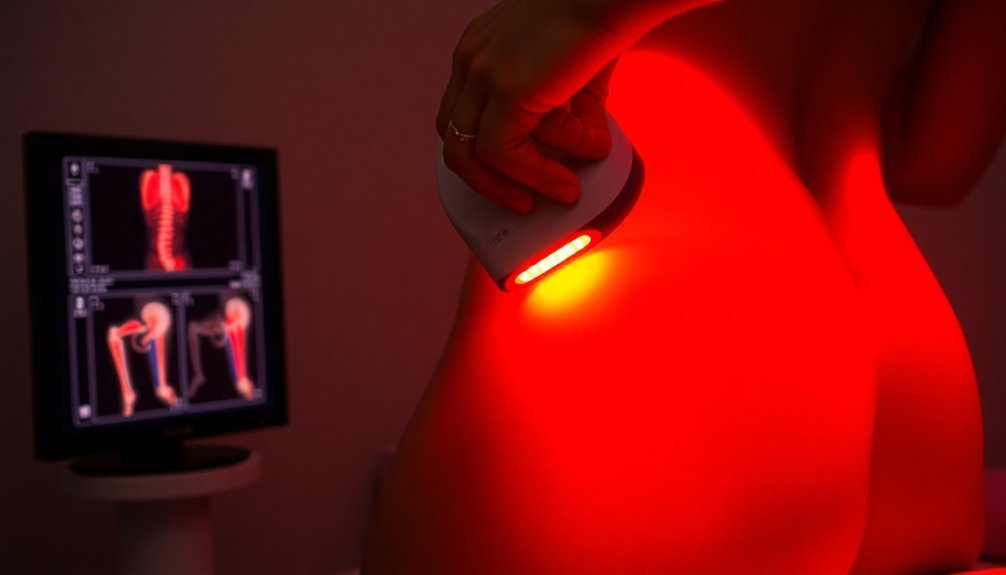
Light has emerged as a powerful ally in bone health through photobiomodulation (PBMT), a therapeutic approach that harnesses specific wavelengths of light to stimulate cellular repair and regeneration. When you receive PBMT treatment, the light penetrates your bone tissue, enhancing mitochondrial respiration and ATP synthesis, which are essential for healing.
You'll find that PBMT works through multiple mechanisms to strengthen your bones. It stimulates osteoblasts (bone-forming cells) while inhibiting osteoclasts (bone-breaking cells), creating a balanced environment for bone regeneration. Research shows that low energy doses of 1 J produce better bone repair outcomes than higher energy levels.
The treatment also boosts collagen synthesis and promotes vascularization, ensuring your bones receive adequate blood supply and nutrients.
The effectiveness of PBMT depends on specific parameters, with the 808 nm wavelength showing particularly promising results. You'll get the best outcomes with lower energy levels, typically between 1-3 joules, as higher energies mightn't be as beneficial.
When combined with biomaterials like biphasic calcium phosphate, PBMT's bone-regenerating effects are even more pronounced. While research continues to refine protocols, PBMT's ability to enhance bone density and promote healing makes it a valuable tool in treating bone conditions.
Red Light Wavelengths Matter
Wavelength selection plays a critical role in the effectiveness of photobiomodulation for bone health. Research shows that three specific wavelengths – 660nm, 810nm, and 940nm – demonstrate remarkable benefits for improving bone density and strength. You'll find these wavelengths particularly effective at enhancing bone mineral density and promoting repair in compromised bone tissue. A consistent treatment approach becomes especially important since bone density decreases naturally with age after 35.
| Wavelength | Benefits |
|---|---|
| 660nm | Enhances bone mineral density and improves biomechanical properties |
| 810nm | Increases bone density with effectiveness equal to other wavelengths |
| 940nm | Promotes bone repair and strengthens biomechanical properties |
| Multiple | Stimulates collagen synthesis and cell proliferation |
When you're using red light therapy for bone health, you'll want to maintain a constant energy density of 4 J/cm². The treatment works by stimulating osteoblast activity while inhibiting osteoclast formation, creating an ideal environment for bone strengthening. You'll see the best results with multiple sessions – typically three times weekly for six weeks. This consistent approach helps activate mitochondrial function and ATP production in bone cells, which are essential for repair and regeneration.
Optimal Treatment Protocols
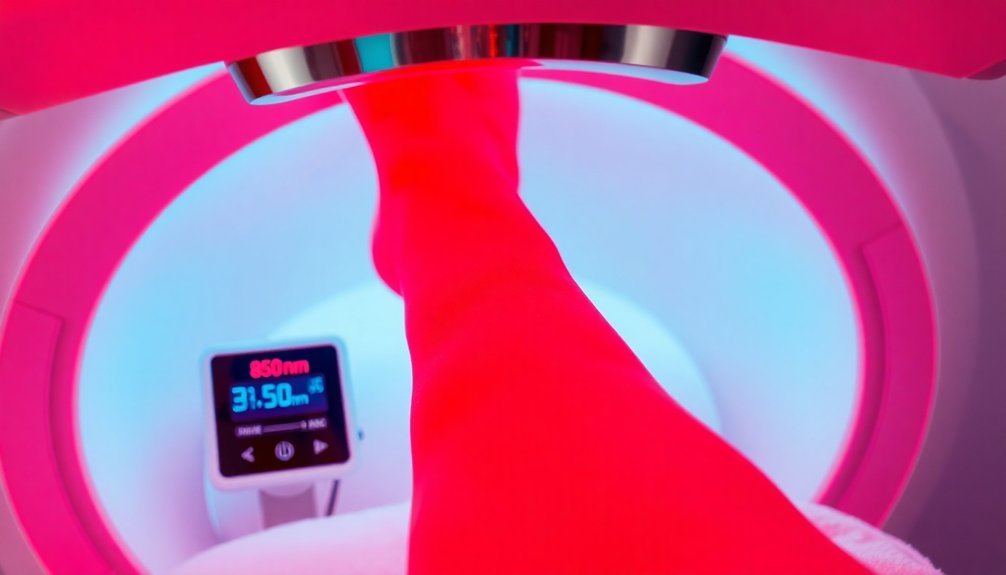
Successful photobiomodulation therapy depends on following precise treatment protocols that enhance bone regeneration. You'll achieve the best results by using specific wavelengths (655 nm, 810 nm, or 940 nm) combined with ideal power densities between 5-10 mW/cm². Research shows that daily treatments or multiple sessions over three consecutive days produce positive effects on bone remodeling.
For the best bone strengthening, you'll want to follow these proven protocols:
- Use an infrared AlGaAs laser device that delivers energy levels between 1-3 joules, as these settings have demonstrated improved bone repair within 15 days.
- Apply the treatment daily to stimulate increased ATP production and enhance osteoblast activity.
- Target specific bone areas for 3-5 minutes per session to promote proper cell differentiation and bone formation.
- Monitor your progress through consistent treatment timing and positioning.
Your bone cells will respond to these protocols by increasing alkaline phosphatase and osteoprotegerin production, leading to enhanced bone density. If you're using PBM for specific conditions like orthodontic tooth movement or osteoporosis, you'll need to maintain strict adherence to these parameters for the best results. Remember, standardization is key to achieving consistent clinical outcomes.
Targeting Common Bone Problems
You'll find photobiomodulation therapy particularly effective in preventing and managing osteoporosis by enhancing bone mineral density and promoting healthy bone cell activity.
When dealing with fractures, PBMT accelerates healing by stimulating osteoblast production while reducing inflammation at the injury site. The therapy helps maintain proper bone remodeling balance between formation and resorption processes.
Your treatment outcomes can improve substantially as PBMT works to strengthen existing bone tissue while supporting the formation of new bone matrix, making it a valuable tool for both prevention and recovery.
Osteoporosis Prevention And Management
The battle against osteoporosis has found a promising ally in photobiomodulation therapy (PBMT), which targets bone density loss through specific light wavelengths. This therapy works by activating cytochrome C oxidase in your cells, boosting ATP production and promoting osteoblast differentiation.
You'll benefit from PBMT's ability to enhance bone mineral density while reducing inflammation, making it a valuable complement to traditional osteoporosis treatments.
Research shows that specific energy densities, like 4 J/cm², can substantially improve bone properties in osteoporotic conditions. You don't need to worry about wavelength specificity, as studies demonstrate that different wavelengths (660 nm, 810 nm, and 940 nm) can be equally effective.
Here's how PBMT fights osteoporosis:
- Increases bone matrix synthesis through enhanced vascularization
- Stimulates cell proliferation and migration essential for bone repair
- Inhibits osteoclast activity to prevent excessive bone breakdown
- Boosts mitochondrial function for improved bone cell energy production
While standardization of treatment parameters is still ongoing, PBMT's proven cellular effects and bone-strengthening capabilities make it a promising option for managing and preventing osteoporosis.
Fracture Healing Support
When bone fractures occur, photobiomodulation therapy steps in as a powerful healing accelerator. PBM treatments boost your bone's natural repair mechanisms by enhancing blood vessel growth and reducing inflammation. The therapy stimulates cellular energy production, leading to improved bone matrix synthesis and faster healing of the fractured area.
You'll find that PBM therapy offers significant pain relief while accelerating the healing process, which often means you'll need fewer pain medications and anti-inflammatory drugs. The 780nm wavelength has shown particular effectiveness in supporting fracture regeneration, though your healthcare provider may adjust parameters based on your specific condition.
If you're undergoing conventional surgical treatment for an open fracture, PBM can serve as a valuable complementary therapy. It works by modifying cytokine levels and inflammatory responses, creating an ideal environment for bone repair. Research has demonstrated that PBM increases bone mineral density and stimulates osteoblast activity – the cells responsible for building new bone tissue.
While treatment protocols continue to evolve, clinical evidence supports PBM's role in enhancing fracture healing outcomes and improving physical function during recovery.
Home Treatment Setup
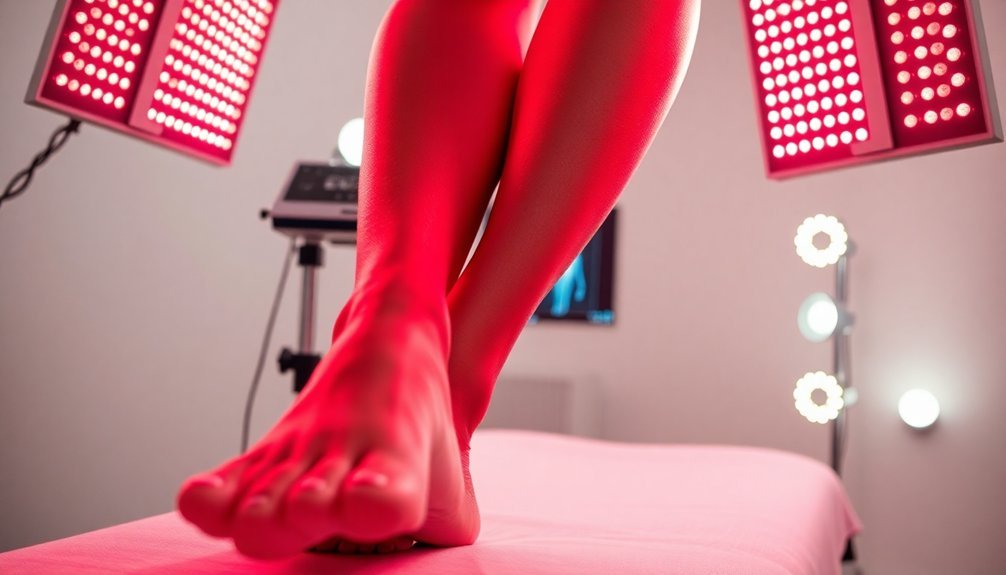
Setting up photobiomodulation treatments at home requires careful attention to device selection and proper positioning techniques.
You'll need to choose an LED device that emits light within the 600-1000nm wavelength range and delivers 4-6 J/cm2 of energy density per treatment. Look for devices with FDA, CE, TGA, and NATO clearance to guarantee safety and effectiveness.
For the best results, position the device directly against your bare skin for 5-10 minutes, once or twice daily. You can treat while lying down with feet elevated or sitting with feet placed on LED panels. Maintain consistent treatment schedules and treat both feet equally, even if only one is problematic.
- Place LED pads or panels in a comfortable, accessible location where you can maintain proper skin contact
- Set up a timer to track your 5-10 minute sessions accurately
- Keep a treatment log nearby to record pain levels before and after sessions
- Position a mirror or camera setup to document any visible changes in inflammation
Monitor your progress by tracking pain levels on a 0-10 scale and watch for any adverse reactions. If pain persists beyond 8-12 weeks, consult your healthcare provider for additional treatment options.
Clinical Success Stories
Recent clinical studies demonstrate remarkable success rates for photobiomodulation (PBM) in bone healing and regeneration. You'll find compelling evidence of PBM's effectiveness in multiple clinical scenarios, particularly in enhancing bone density and accelerating healing processes.
When doctors combine PBM with titanium surface patterning, they're seeing significant improvements in osseointegration, especially in osteoporotic bones.
At the 4J energy level, patients experience increased bone mineral density, while those receiving 1J treatments show notable osteoblast growth within 14 days post-surgery.
You'll be interested to know that PBM's success extends to treating medication-related osteonecrosis of the jaws and improving bone density in patients with chronic spinal cord injuries. The therapy works by stimulating TGF-β expression and promoting osteoblast differentiation during early healing stages.
What's particularly exciting is PBM's success in combination therapies. When your healthcare provider pairs PBM with specific biomaterials or surface treatments, you'll benefit from enhanced bone regeneration and improved implant anchoring.
These synergistic effects are proving especially valuable for patients requiring dental implants or bone repairs.
Science Behind Light Therapy
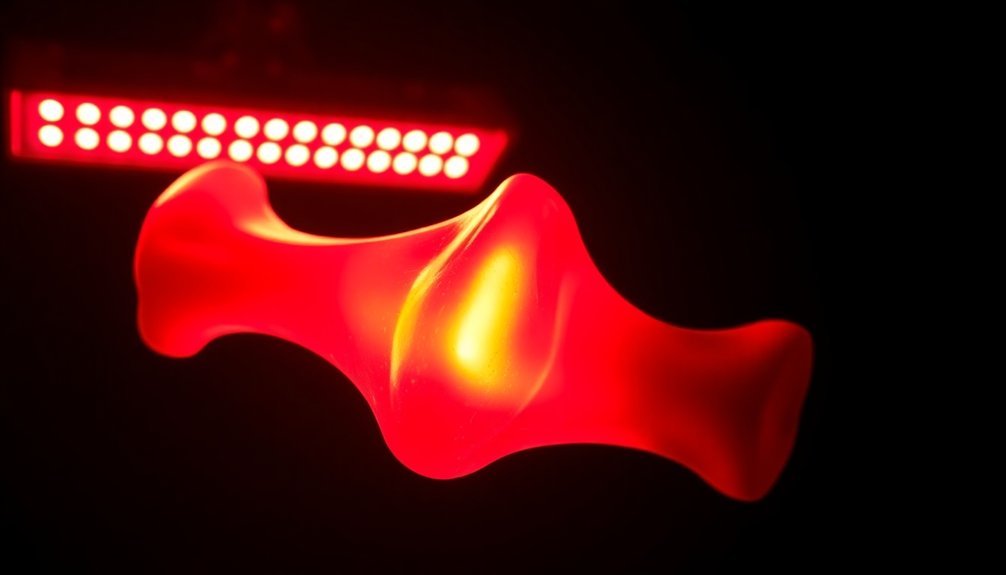
Three key mechanisms drive photobiomodulation's effectiveness in bone healing. When infrared light penetrates your bone tissue, it stimulates mitochondria to produce more ATP, energizing cellular repair processes.
The therapy also triggers your mesenchymal cells to transform into bone-building osteoblasts while suppressing bone-degrading osteoclasts. Additionally, it boosts blood vessel formation, ensuring proper nutrient delivery to healing bone tissue.
Your body responds to photobiomodulation through these specific biological changes:
- Enhanced mitochondrial function leads to increased ATP production, powering the energy-intensive process of bone regeneration
- Growth factors like TGF-β become more active, accelerating bone matrix formation and mineralization
- New blood vessels develop around the treatment area, delivering essential nutrients and oxygen
- Collagen production increases, strengthening the bone's structural framework
The effectiveness of your treatment depends on precise parameters. You'll get the best results with wavelengths between 635-980 nm and power outputs of 40-100 mW. Lower energy densities under 100 J/cm² typically work best, though your specific condition may require adjustments to these parameters for maximum benefit.
Combined Therapy Approaches
Powerful synergies emerge when you combine photobiomodulation with targeted biomaterials for bone regeneration. When you pair PBMT with materials like biphasic calcium phosphate or fibrin biopolymer, you'll achieve superior bone healing results compared to using either treatment alone. The combination accelerates the regeneration process and promotes higher mineralization rates in your bones.
You'll find particularly promising results when using PBMT with specific biomaterials like Bio-Oss collagen or mineral trioxide aggregate (MTA). These combinations lead to better bone maturation and enhanced integration of the biomaterial into your newly formed bone tissue.
For ideal results, you'll want to use PBMT at specific wavelengths – 660 nm, 810 nm, or 940 nm – with an energy density of 4 J/cm².
You can benefit from these combined approaches in various clinical scenarios, especially in dental surgery and alveolar bone repair. While researchers continue to study the most effective combinations, you'll find that current evidence strongly supports using PBMT alongside biomaterials for enhanced bone regeneration.
This dual approach offers you a powerful strategy for achieving stronger, denser bones through accelerated healing and improved tissue integration.
Measuring Your Treatment Progress
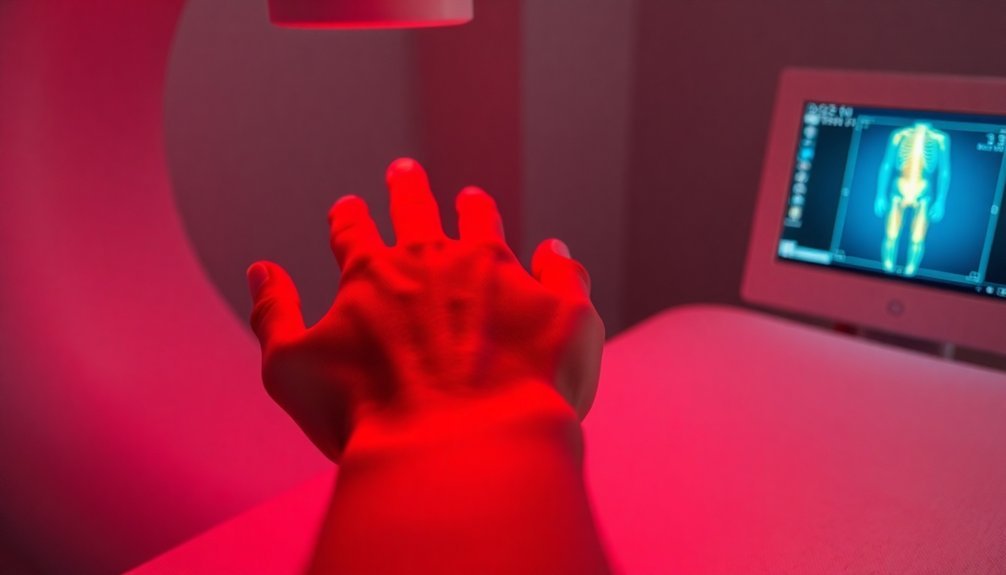
To track your photobiomodulation treatment's effectiveness, you'll need regular bone density scans that measure changes in your bone mineral density through gray-scale imaging.
Your progress should include monitoring joint mobility improvements, which directly reflect how well your bones are responding to the therapy.
Monthly progress photos can help you and your healthcare provider visualize physical changes and healing patterns, especially in cases involving visible bone injuries or alignment issues.
Bone Density Scan Results
Measuring your bone density scan results provides essential insights into how well your photobiomodulation treatment is working. Your doctor will likely use DXA scanning, the most reliable method, to track your progress through T-scores and Z-scores that compare your bone density to standard reference values.
You'll need regular scans every 1-2 years to monitor how your bones respond to the treatment.
- T-scores above -1.0 indicate normal bone density
- Scores between -1.0 and -2.5 suggest osteopenia (low bone mass)
- Scores below -2.5 indicate osteoporosis
- Your improvement rate helps determine if PBMT is effective
During your follow-up appointments, your healthcare provider will analyze these scores, focusing particularly on areas prone to fractures like your hip and spine.
The DXA scanner uses two X-ray beams to measure your bone density precisely, while newer technologies like DXL may offer even more accurate results by incorporating laser measurements. If you're participating in PBMT research studies, you might also experience additional scanning methods like QCT or QUS, which can provide complementary information about your bone strength and structure.
Understanding these results helps you and your healthcare team adjust your treatment plan for ideal outcomes.
Track Joint Mobility Gains
Throughout your photobiomodulation treatment journey, tracking joint mobility improvements provides essential feedback about your therapy's effectiveness. You'll need regular range of motion (ROM) assessments using tools like goniometers to measure your progress, especially for knee joint flexion and extension movements.
Your healthcare provider will likely use standardized tests to evaluate your improvements. These include the Western Ontario and McMaster Universities Osteoarthritis Index (WOMAC), sit-and-stand tests, and 2-minute walk tests. These assessments help measure both your pain reduction and physical function gains.
You'll want to guarantee your treatment follows established guidelines for ideal results. The most effective photobiomodulation parameters typically include wavelengths between 780-860 nm and energy densities of 4-8 J/point.
When combined with strength training, you're likely to experience enhanced mobility gains compared to using either treatment alone.
Keep track of your progress through regular follow-up assessments. Pay attention to improvements in your quadriceps strength, reduced joint stiffness, and increased range of motion.
Long-term monitoring will help confirm whether you're maintaining the mobility gains achieved through your photobiomodulation therapy.
Monthly Progress Photos
While tracking joint mobility provides valuable insights, documenting your bone healing through monthly radiographic images offers concrete evidence of your treatment's effectiveness.
Regular radiographic evaluations can show improvements in your bone density and help your healthcare provider assess how well your photobiomodulation therapy is working. You'll need to follow standardized imaging protocols to guarantee accurate comparisons over time.
- Schedule monthly imaging sessions at the same facility to maintain consistent protocols and equipment calibration
- Work with your provider to track bone density measurements using specialized software like Digora
- Keep detailed records of your PBM treatment parameters alongside your imaging results
- Request histological evaluations when recommended to assess osteoblast activity
Your monthly progress photos will reveal changes in bone mineral density and tissue regeneration that aren't visible to the naked eye. These images allow your provider to measure the effectiveness of different PBM parameters and adjust your treatment plan accordingly.
When combined with specialized imaging software, you'll get quantitative data showing how your bone density improves over time. This systematic approach helps guarantee you're getting the most benefit from your photobiomodulation therapy while providing valuable documentation of your healing progress.
Frequently Asked Questions
Can Photobiomodulation Help With Bone Fractures That Haven't Healed Properly?
Yes, photobiomodulation can help your poorly healed fractures by stimulating bone formation, increasing blood flow, and reducing inflammation. It's particularly promising for treating non-unions through its cell-stimulating and tissue-regenerating properties.
How Long Should I Wait After Surgery Before Starting Photobiomodulation Treatments?
You don't need to wait – you can start photobiomodulation immediately after surgery for pain and inflammation control. You'll get the best results if you begin treatment before leaving the hospital, using non-contact delivery.
Does Taking Calcium Supplements Affect the Effectiveness of Light Therapy?
Based on current research, there's no evidence that calcium supplements affect your light therapy's effectiveness. You can safely continue taking calcium while doing light therapy, as they work through different mechanisms.
Can Children Safely Undergo Photobiomodulation Therapy for Bone Conditions?
Yes, your child can safely receive photobiomodulation therapy for bone conditions. It's proven safe for children in clinical settings, though you'll need a qualified healthcare provider to administer the treatment properly.
Will Photobiomodulation Interfere With Bone Density Medications or Osteoporosis Treatments?
You don't need to worry about interference – photobiomodulation works safely alongside bone density medications and osteoporosis treatments. It's actually been shown to enhance their effects without causing any negative interactions.
In Summary
You've now got the knowledge to strengthen your bones using photobiomodulation therapy. Whether you're using clinical treatments or a home device, stick to proven wavelengths and protocols. Track your progress, combine treatments when needed, and stay consistent. With proper application of red light therapy, you'll support your bone density and overall skeletal health. Remember, it's an ongoing journey – keep monitoring and adjusting your approach.





Leave a Reply